The Road Trip
Goto: Home
The purpose of this trip was two-fold: Sean had purchased some SGI computers
and 21" monitors from a guy living in Ypsilanti, which he did not want
to pay to have shipped to Kalamazoo. Furthermore, Nathan, Sean and myself were
about to move into a dorm room in Couzens Hall at the University of Michigan
in Ann Arbor to start our first year of college, and we wanted to find out if
we could see our new room or at least see a floorplan for it so that we could
know what to expect when we moved there.
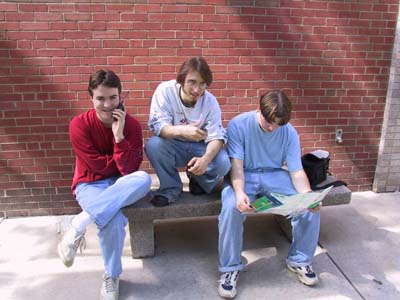
Left-to-Right, Me, Sean and Nathan on a bench outside the housing administration
building.
When we got to Ann Arbor, we drove around for maybe 15 minutes with
everybody cussing at each other and Nathan trying to read the map, but we eventually
found Couzens Hall, our dorm. Unfortunately, it was locked. We walked all around
the building and tried all the doors, and then I tried running my old University
ID cards from Camp CAEN through the card readers on the doors, and my credit
card, and ATM card, but none of them opened the lock. We then drove over to
some kind of administration building, and asked if they could show us a floorplan
or tell us the dimensions of our dorm. They said that they couldn't, but that
the office across the hall might be able to. We went across the hall, and the
people in that office said that only the people in the first office would be
able to help us! We went back to the first office, and the girl at the desk
went and got her boss or supervisor or something, who tried to help us, but
wasn't able to in the end, because they didn't have that information in that
office. So, we proceeded on from there to Ypsilanti.

Sean and Charlie climbing all over the University of Michigan.
We got off at the Ypsilanti exit and drove by this nice-looking automotive factory on the way to the guy's house,
which we found pretty readily. When we got there, the guy and his son brought out these Dell Computer boxes --
this was one of those new "Dell" branded Indigo2's! Well, not really. Apparantly, he had packed them up in the
Dell boxes because he was going to ship them to somebody overseas, but that person never came through with the
money or something. So, Sean and the guy and his son loaded the computer and monitor into the back of Charlie's
van, and then the guy offered to give Sean a couple of SGI Indigos for free, because he was moving and didn't
want to bother with them. So of course Sean took him up on the offer. We then left the guy's house and headed
back towards Kalamazoo, and argued about whether Sean was going to donate one or more of the free Indigos to one
or more of us.
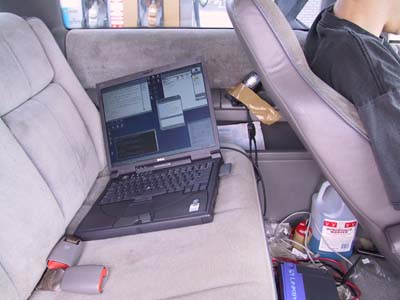
My laptop, the cell phone & the base station.
Those were the actual events of the trip, but in our minds, they
were not the main point of the trip at all. The main point of the trip was the
"3l337" computer set-up that we had going in the van. We had four laptops: Two
Dell P3-850's (mine and Charlie's), Sean's iBook, and Nathan's P-75. Sean's
and Nathan's laptops were plugged into Charlie's combo Ethernet hub and 802.11b
base station. My laptop and Charlie's laptop were connected up through the wireless
base station, using 2.4GHz 802.11b. Then, my laptop was hooked up to the Internet
for the entire time, through my cellular phone. My service plan [at that time]
included unlimited incoming minutes, which counts for circuit-switched data
calls as well as regular voice calls. So, I set up a Dialback PPP server on
my home computer using an analog phone line & modem to talk to the cell phone,
and my cable modem as the outgoing Internet connection. After connecting to
the Internet through the cell phone, I set up Windows 2000's IP Masquerading
(NAT) service, and shared the Internet connection with everyone else on the
"VAN" (Vehicular Area Network). Or just the van, if you want to think of it
that way.
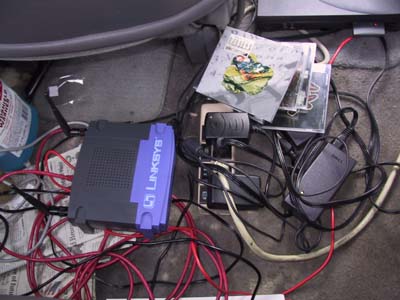
The base station, a laptop power supply, and the first powerstrip.
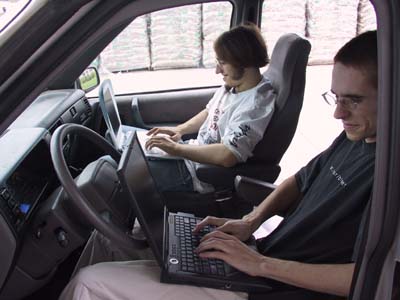
Sean and Charlie playing
on their laptops at the gasstation.
You might wonder how we were going to power all this equipment.
Our laptops certainly have batteries, but batteries don't last forever, especially
in Nathan's laptop, which is pretty old. The Nextel is only good for maybe a
couple of hours of talktime (max) on one battery, and this trip was more like
six hours long. Also, the base station & hub does not have any battery capabilities
at all. So, Sean and I brought our inverters along. My inverter is more powerful
than Sean's, but it was suspected of being a bit flaky. I got it from Nathan
because it was broken and his family had bought a new one. I opened up its cigarette
lighter plug and noticed that one of the wires was loose, so I re-soldered it,
and the inverter appeared to work after that. However, we had taken it on a
semi-long trip once before, and it kept failing. We taped it to the dashboard
[to avoid putting stress on the power cable connector], and it more or less
worked after that, but it also interfered with the car's stereo system quite
badly. On this trip, we tried Sean's inverter, and it didn't interfere with
the stereo, and it also didn't stop working every now and then. It wasn't powerful
enough to run all of our electronic devices all at once though, so we left the
cell phone and the base station / hub plugged in for the duration of the trip,
and took turns plugging in the laptops. If the trip had been longer, we might
have run into laptop problems, but our batteries held out (with the periodic
recharging from the inverter) just fine. It looked pretty crazy though, having
two power strips hooked up to an inverter in Charlie's van -- we had the first
power strip situated between the front two seats, plugged into the inverter.
We then plugged the cell phone, the base station/hub, and the second power strip
into it. The second power strip was located in the back seat, and we took turns
plugging the laptops into it.
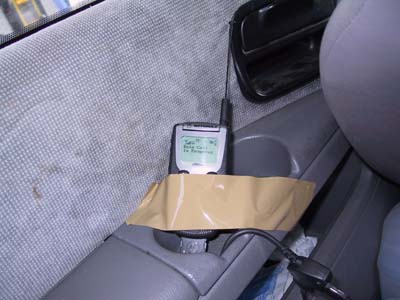
Data Call in
Progress!
When using the Nextel circuit-switched data system, your phone transmits/receives
data at a rate of 19,200 bits per second. However, half of these bits are used
for their forward-error correction protocol, which is supposed to ensure that
even if the data frame gets scrambled a little bit while going over the air,
it will still be usable, and won't have to be retransmitted. This seems to work
pretty well, but it does limit the actual throughput to 9,600 bits per second.
The connection worked great on the way to Ann Arbor and Ypsilanti - we didn't
have any trouble with getting disconnected, and we were using the connection
to get on IRC, talk on AOL Instant Messenger to some other friends of ours,
and actually to surf the web a little bit. The web-surfing proposition worked
a lot better with images turned off though. It was rush "hour" for most of the
trip back from Ypsilanti, and there were lots of cars on the freeway. I guess
that lots of the people in these cars must have been talking on their Nextels,
because the data call between my Nextel and my computer at home got dropped
a few times. I imagine that this was because my phone was losing its connection
to the tower that we were leaving behind as we drove, but that the tower(s)
that we were approaching were full to capacity handling other peoples' phone
calls, so when the signal from the tower my phone was on finally gave out, there
was no room for my phone on any of the towers it could hear, so the call just
dropped. As we got nearer to Kalamazoo, the traffic lightened up some (it was
getting past rush hour by that time), and the connection became more stable.
Although we didn't get into the dormitory building and didn't get to see any
floor plans or room dimensions, the trip was pretty much a success, and lots
of fun, too. We were taking pictures with Nathan's grandfather's digital camera,
which he had loaned us, and I actually was able to show a couple of them to
my friends at home and elsewhere while still on the road by uploading them to
the diablonet (Sean's server) through the cellular phone.
Extra Photos:
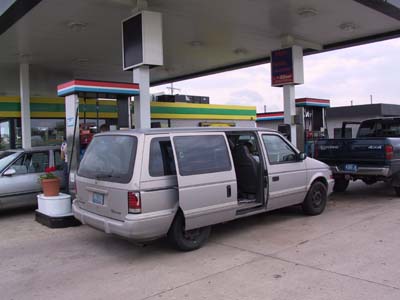
The van, filling up at a gas station.
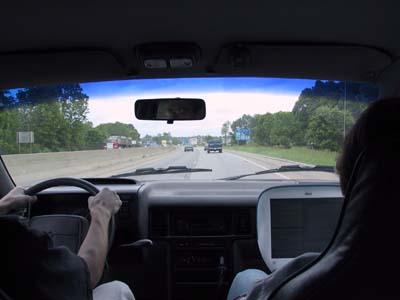
Drivin' down the road, Sean playing with his iBook.







